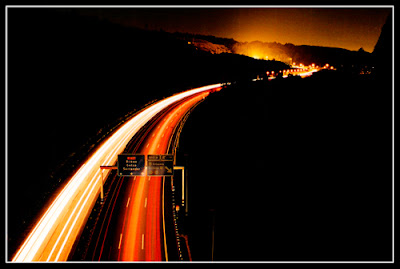Motion blur is induced when the camera actually sees the movement in the scene due to slower shutter speeds. A shutter blinking fast will not see any movement, but a shutter that stays open for longer periods will see the elements in the frame move. Motion blur could produce impressive results if used creatively. It kind of gives life to the shots and conveys a sense of action better than many other kinds of photography. Although motion blur is mostly used in sports photography, almost all kinds of subjects whether their move is small, slow or subtle could benefit from motion blur photography by giving emphasis to the action. So here in this article, let us discuss how we could creatively capture some movement in our shots.
 |
| Photo by Kainet |
Tips For Capturing Motion Blur
So from the above paragraph you might have understood that in order to capture motion blur we need to shoot at very slow shutter speeds. So our primary goals are to achieve the slow shutter speeds we require and to keep the camera stable through the exposure. May sound easy but achieving very slow shutter speeds in bright lighting conditions is a bit tricky. Let’s see what all are the elements we could control / tweak to achieve our goals.
Tripod and Cable / Wireless Release
To achieve motion blur it is essential to shoot at very slow shutter speeds and to get sharp images while shooting at very slow shutter speeds a sturdy tripod and a cable / wireless trigger release is a must. So mount your camera on a sturdy tripod or place it on some level surface to eliminate blur caused by camera shake.
ISO
Choose the lowest ISO setting on your camera. This has multiple advantages, you will have less noise on your images and you will be able to get slower shutter speeds. For most cameras the lowest setting is ISO 100.
 |
| Photo by Matt Eckelberg |
Neutral Density (ND) Filter
If you are attempting to capture motion blue in broad day light, the combination of lowest ISO setting your camera allows + Highest Aperture setting for your lens will not be able to achieve slow enough shutter speeds to capture the motion blur. Resulting in overexposed / blown out images. If faced with such a situation use a Neutral Density (ND) filter to reduce the amount of light reaching your camera’s sensor.
Polarizing Filter
You could use a Polarizing Filters instead of Neutral Density (ND) filters but keep in mind that polarizing filters not only reduce the amount of light that reaches your cameras sensor but also cuts out reflections and changes the colour saturation especially when it comes to the colour of sky (a sky appears deep blue when a polarizing filter is mounted on to lens) etc. So try experimenting by rotating the polarizing filter and choose the setting that gives the best results.
Shutter Priority (TV) Mode
Shutter Priority mode is the setting to use when the most important factor that you wish to have control over is shutter speed. While shooting in Shutter Priority mode the camera determines the best aperture value for the shutter speed you have selected and properly exposes your frame. This works for most occasions. If not switch your camera to Fully Manual (M) mode and dial in the settings manually.
 |
| Photo by Dr. Sayid Budi |
Manual Mode (M)
While operating in Manual mode you have two options if you are not very sure of your exposure settings.
First method is to switch back to Shutter Priority Mode, choose your desired shutter speed, point your camera to the subject, half press the shutter button to meter, memorize the values for aperture and shutter speeds and then switch to manual mode and dial in the values manually.
Second method is to take a few trial shots and find out the best settings for the given situation through trial and error method.
It is always better to bracket your shots using Automatic Exposure Bracketing settings in your camera. On many occasions, while viewing your images on the large computer screen you will end up liking photos with different settings than you originally / intentionally set.
Shutter Speed
When we say slow shutter speeds, we are actually comparing the shutter speed in relation to the speed at which our subject is moving. Faster moving subjects like a racing car could be caught in motion with a shutter speed of 1/125. But slower moving subjects like a person running will require a much slower shutter speed of 1/30 or slower to capture some blur.
 |
| Photo by Kennymatic |
So the shutter speed funda for capturing motion blur is slower shutter speeds for slower moving subjects.
So grab your camera and your tripod, go out shoot some motion blur images and let us know how it all went. The above mentioned method is not the only way to capture motion blur, there are other techniques as well like zooming, panning etc which we will discuss later.
In the next article we will discuss about Photography - How To Photograph - How to Get Shallow Depth of Field in Your Digital Photos
So grab your camera and your tripod, go out shoot some motion blur images and let us know how it all went. The above mentioned method is not the only way to capture motion blur, there are other techniques as well like zooming, panning etc which we will discuss later.
In the next article we will discuss about Photography - How To Photograph - How to Get Shallow Depth of Field in Your Digital Photos
Post a Comment